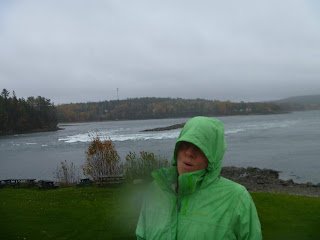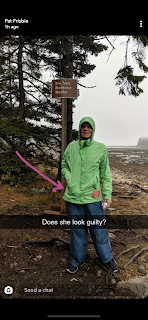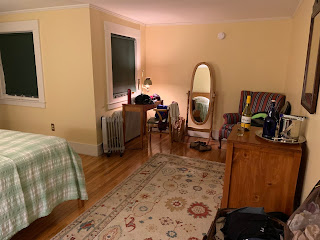Collect rocks? What can I say about Mona's collecting? What first springs to mind is Lucille Ball who's character in the movie "The Long, Long Trailer" hid her immense rock collection in the trailer while Desi navigated a cliffhanging route through the mountains. Like Lucy, Mona can't resist a souvenir rock. During our hike along the Rhode Island's Cliff Walk, I scrambled down a steep embankment to the water. I called to Mona to follow and she declined until I mentioned, "There are some rocks down here." Next thing I know, she's down the embankment and scouring the shore for interesting rocks.
But a better comparison is the activities of one 18th-century European polymath, Alexander von Humboldt. Humboldt travelled extensively through Central and South America documenting his explorations with a scientific view and collecting everything he could. At one point, Humboldt almost drowned crossing a Venezuelan river because he overloaded his canoe with rocks, seeds, plants and even live animals.
Like Humboldt, Mona collects everything: rocks, shells, leaves, drift wood. Once she smuggled giant seeds from Costa Rica. The seeds were the size of ping pong balls. Mona displayed them in a decorative bowl. Several months later, she heard a loud popping sound and discovered the seeds had burse open -- releasing who knows what into our house.
After that, I was a little more circumspect about bringing home biological agents from foreign lands. On a bicycle ride to Grazalema, Spain, we found ourselves in a forest of cork trees. The bark of the cork tree is harvested every nine years leaving the trunk of the tree looking much like a freshly shaved poodle. The bark is thick and spongy and, of course, Mona collected some samples.
"You know, the Emerald Ash Borer was introduced to the US via the bark of shipping pallets." I cautioned Mona. "We could get in real trouble bringing that cork bark home."
"Oh, you're such a goodie-two-shoes. Take some chances in life!" she replied as she hid the cork in her luggage. There was no reasoning with her. I did quarantine the bark in a plastic container until I could seal it with polyurethane. It looks very nice displayed next to the burst Costa Rican seeds in a large bowl on our dining room table.
The bowl holds an interesting collection: a dozen perfect Sand Dollars from San Vincent Island, an alligator's tooth from Wakulla Springs, a 1.7 billion year-old piece of Vishnu Schist granite from the North Kaibab Trail that tried to kill me, an Orioles' nest, the claw of a Great Horned Owl. Each item has a story and if you bring some wine, we'll tell you all about it.
Not everything gets displayed. Our kids followed Mona's example in collecting treasure. When each vacation resulted in an additional box of shells, rocks, drift wood and even baggies of beach sand, we needed to make some compromises. The compromise was to dump the excess outside, along the foundation of our house. No need to go to Florida, you can beach comb right outside our front door.
Sometimes I have taken stricter measures to curtail the collecting. When the kids were little they would hand me "a treasure" to bring home every 100 yards. My technique was to dump the stuff temporarily behind a trail marker or some other easily remembered landmark. If the kids remembered and asked, I'd go back and get it. If they didn't remember, which was usually the case, it stayed there to be found by the next lucky treasure seeker. "Oh look, a stick!" Even with my precautions, I still occasionally find my pack a little heavier at the end of the hike. "How did these rocks get in my side pockets?"
L-u-u-c-y!
---
 |
| Schoodic Peninsula |
After our hike near the B&B, we drove to Acadia's Schoodic Peninsula. Not as dramatic as the main part of the park on Mount Desert Island, the drive around Schoonic Peninsula offers nice views of the water and access to some easy hiking. By the time we circled the park, the rain had stopped and we enjoyed a very nice picnic dinner at Frazier Point.
 |
| Sunset at Frazier Point, Schoodic Peninsula |
The next and last day at Acadia was cool, clear and breezy. A good day for hiking. My niece Emily had posted a recommendation to my Instagram account, "Do the Precipice trail. It's my favorite trail ever!" Based on the trail's name and the fact that the recommendation came from someone who convinced her father to build a trapeze in the back yard so she could train to become a circus performer, I carefully read the trail descriptions before committing to a route.
 |
| You've been warned |
The trail descriptions included the phrases "exposed cliffs that require climbing on iron rungs" and "serious injury and death." Hey, this could be fun. In order to dial it back a notch, I suggested we hike/climb the Beehive Trail which seemed to be a slightly easier version of the Precipice Trail.
 |
| The moment Mona realized she might die |
I was very explicit with Mona about the route and she was game until we got to the second set of rungs and she realized that "serious injury and death" was not an exaggeration.
"It's too late to turn back," I told her. "It's more dangerous to climb down than up. We must go up. From the top, there's an easier route back down." With that, Mona stiffened her resolve and climbed on.
 |
| But didn't |
The scary part didn't last too long and quicker than you can say "acrophobia" we were having lunch looking out over the Atlantic Ocean.
On our return home, I drilled holes in Mona's Acadia rocks and mounted them on a steel stand in the garden. Not quite the same as the sculpture in Maine, but I'm calling it a win.
 |
| Acadia-sourced rocks, an artisan stand, $24 in masonry drill bits and 2 hours of drilling. |
 |
| Biking route at Acadia N. P. |
Six states, ten days, twenty miles hiked, one hundred miles biked. Great trip.
| State: | Maine |
| Date: | 2019-10-22 |
| Route: | Hulls Cove Visitor Center to Jordan Pond House |
| Distance: | 18 miles |










































